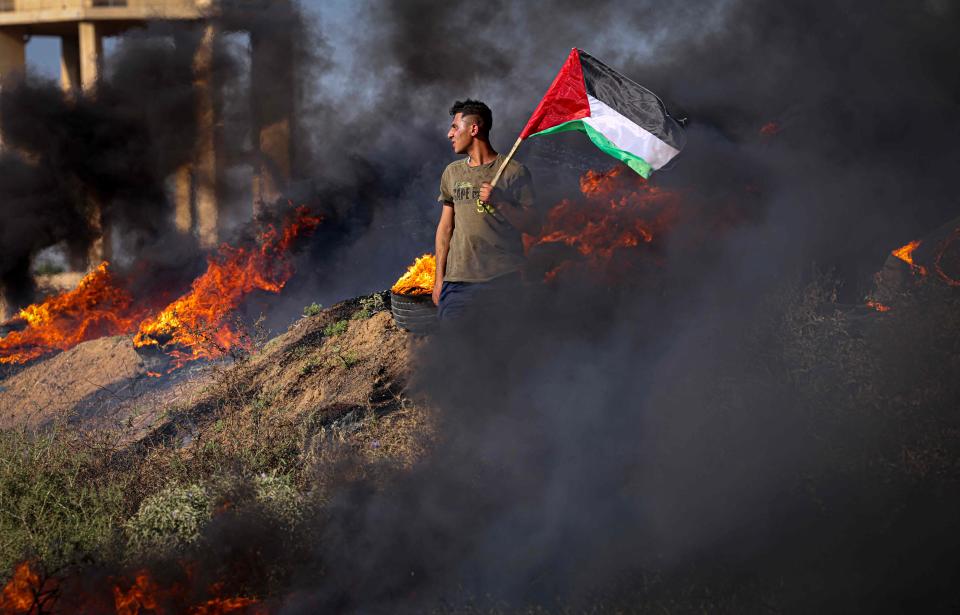England: Responsibility for the Israeli-Palestinian 'cycle of violence' is far from equal

- Oops!Something went wrong.Please try again later.
For two days in early July, Israeli Defense Forces (IDF) and Palestinian militants traded gunfire in Jenin, a city in the northern West Bank. More than a thousand IDF troops supported by aerial drones entered Jenin and engaged armed militants even though, under the 1993 Oslo Accords, the Palestinian Authority (PA) is responsible for policing most Palestinian cities.
Why, then, did the IDF engage in this brief military operation? The answer is two-fold. One reason for the IDF operation in Jenin is that it had become a hub for terrorist attacks on Israeli civilians, some in Jerusalem and others in Tel Aviv. During the months prior to the Jenin operation, dozens of Israeli civilians were killed or wounded during shootings, stabbings, or car rammings by Palestinian militants. It is likely that the final straw for Israeli leaders was the two rockets launched from Jenin during early July that were aimed at the Israeli village of Gilboa.
Second, Mahmoud Abbas, the aging president of the Palestinian Authority, is increasingly unpopular with his people. PA officials (including Abbas himself) are notorious for their corrupt and authoritarian rule. This growing unpopularity means that the PA is losing control of cities like Jenin. Iran has rushed to fill the political void in the West Bank and is now funding and advising groups like Hamas and Palestinian Islamic Jihad. Israeli military and political leaders have to fear an Iranian presence in the West Bank because Teheran has repeatedly threatened to destroy Israel. To put things in perspective, imagine the threat to Israel posed by Iranian-supplied rockets only ten miles from Tel Aviv.
What were the aims of IDF commanders as they launched their operation in Jenin? They sought to capture, and if necessary eliminate, suspected terrorists based in the city. They also sought to destroy weapons factories and stockpiles used to arm Palestinian terrorists. This brief incursion was at least partly successful. Arms caches, including one hidden in a mosque, were found and destroyed. The IDF says its troops questioned over 300 Palestinian suspects in Jenin, though only 30 of them were taken in for additional questioning. Twelve armed combatants were killed resisting arrest whereas no Palestinian civilians died during the operation.
How were casualties limited? An answer has been provided by Col. (ret.) Richard Kemp, former commander of British forces in Afghanistan: “No army in the world acts with as much discretion and care as the IDF in order to minimize [civilian] damage.” During the recent fighting in Jenin, the IDF relied heavily upon foot soldiers in armored vehicles to detain suspected terrorists instead of relying on its superior airpower to kill suspects. The IDF also sent text messages to the residents of Jenin warning them to stay in their homes and away from combat. Compare that to Vladimir Putin’s use of artillery and bombers to utterly destroy the Russian city of Grozny during a 1999-2000 rebellion. Thousands of Muslim civilians died during the destruction of Grozny, and the Western world barely noticed.
The reaction to the recent IDF operation by some media outlets and politicians has been predictably negative and, in some cases, maliciously misleading. U.S. Representative Ilhan Omar has described the operation as a “massacre” despite the small number of casualties. Others have accused the IDF of “killing children” because several of the Palestinian dead were teenagers. Those critics need to face the fact that those teenagers were armed combatants and members of terrorist groups that aim to kill Israeli civilians.
Counterpoint: Azzi: In Jenin, Palestinians refuse to go gentle into that good night
A cliché repeated by State Department and UN officials as well as media commentators is that Jenin was just the latest round of a “cycle of violence between Israelis and Palestinians.” That cliché, however, fails to assign responsibility properly for violence between Palestinians and Israelis. We tend to forget that the United Nations proposed partitioning British-governed Palestine between its Jewish and Arab communities after World War II. The Jews of Palestine accepted the UN partition plan, but the Arabs did not. When Israel declared its independence in 1948, Palestinian Arabs and the armies of surrounding Arab states tried unsuccessfully to destroy Israel in its infancy. Once again in 1967 and 1973, Arab armies tried and failed to eradicate the State of Israel.
Since that third military defeat, its enemies have used terrorist attacks and propaganda campaigns instead of conventional warfare in an effort to undermine Israel’s very existence. Those enemies seek to murder Israeli civilians whenever and wherever they can. The IDF, on the other hand, tries to arrest or kill armed terrorists who threaten the lives of innocent Israelis. It does not target Palestinian civilians. Responsibility for the “cycle of violence” is far from equal.
Richard England is a retired UNH economics professor and an active member of the Jewish Federation of New Hampshire.

This article originally appeared on Portsmouth Herald: England: Responsibility for the 'cycle of violence' is far from equal

